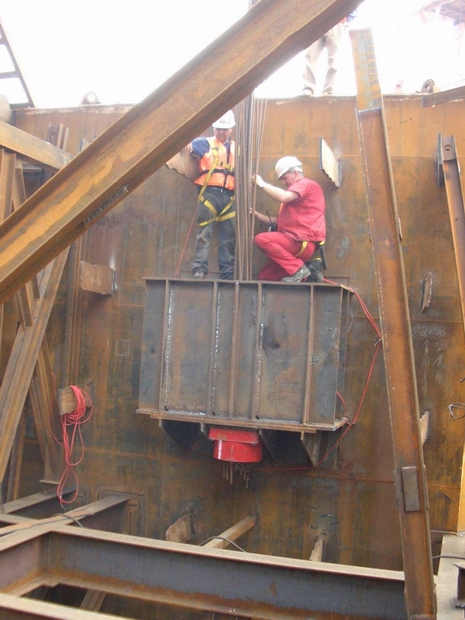Reference Project
Construction Engineering
Site Services
The Sutong bridge across the Yangtze river near Shanghai has a main span of 1088m, which made it the longest cable stay bridge in the world until 2012. Construction of the 118m x 52.3m x 18m thick pile cap to the main cable pylon P4 was undertaken by CHEC.2nd Navigation Engineering Bureau, the main contractor for the north side foundations and approach spans. The reinforced concrete pile cap is supported on 135 No. 2.85m diameter steel piles and has a 2m thick permanent steel caisson to the sides which is designed to minimise damage to the pile cap during ship impact. This steel caisson also acted as permanent formwork for casting of the pile cap concrete. The bottom 7m of the caisson was assembled above water level on temporary support brackets welded to the piles, and then carefully lowered into the water using strand jacks. DLT were heavy lift sub-contractors to CHEC for this lowering operation, which took place on October 19th 2004.

The lowering operation was carried out using 16 No DL-S418 strand jacks, each jack having a safe working load of 418 tonnes, powered from 4 No DL-L114/4/D hydraulic power packs. The whole operation was controlled using the DL-P40 computer control system, which uses a state of the art CAN network for ultra reliable communication between jacks, power packs and the control computer. Accurate control of load distribution between the jacks was essential for a safe lift and to achieve this the client specified a maximum differential movement between any two jacking points of 10mm. The 3050 tonne, 7m deep, caisson was an unusually stiff load to handle as a relative movement of 10mm between adjacent jacking points would cause a load redistribution of 35% of the jack load, a situation which would quickly lead to a jack overload if not automatically detected and corrected by the DL-P40 control system. Periodic level surveys and strain gauge readings were taken around the box by the client during the lowering operation to check that we were achieving this requirement. The DL-P40 computer control system has intelligent nodes at each jack that constantly monitor the jack stroke in relation to the max/min jack stroke advised to it by the DL-P40 control unit, and can instruct the power pack to adjust the oil flow to itself to maintain its position within the required stroke range. In practice it was found that a stroke range of just 5mm was required to maintain a stable load balance between the jacks.


DL-S410 strand jacks powered by DL-L114/4/D power packs. Each of the diesel powered hydraulic power packs can operate up to 4 jacks

Strand jacks were mounted on temporary cantilever frames, evenly spaced around the perimeter of the caisson, and were connected to temporary jacking brackets welded to the inside wall of the caisson
